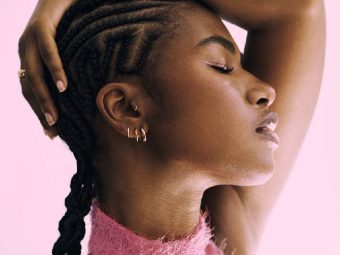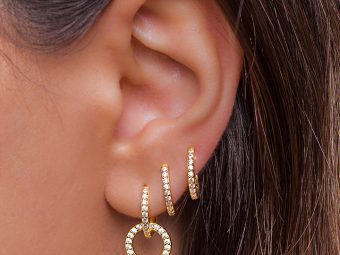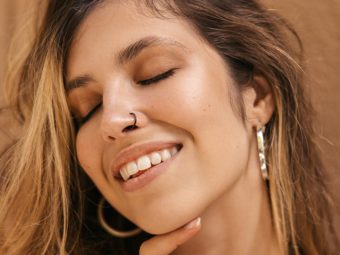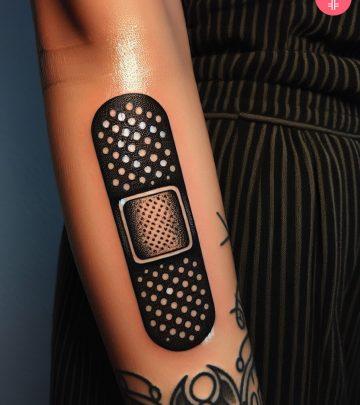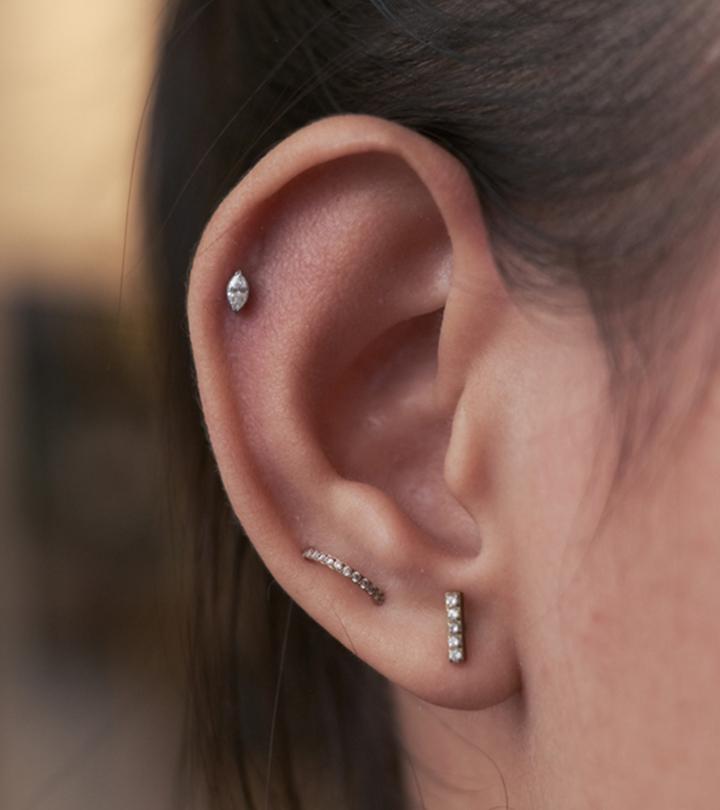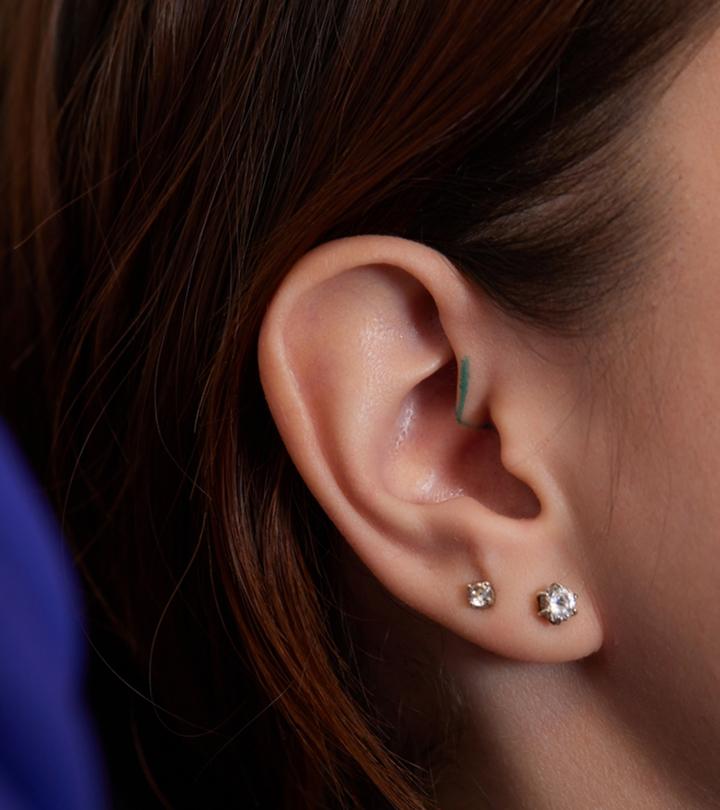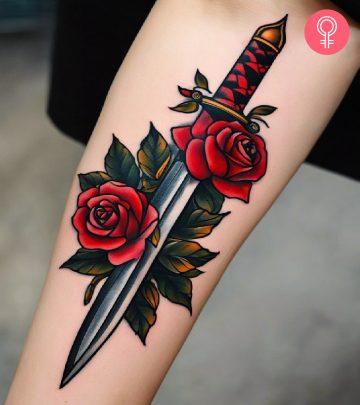Men Piercing Guide: Types, Jewelry & Tips To Choose The Best
Enter the world of the hottest piercings to give yourself a trendy makeover.

Image: Shutterstock
When it comes to choosing a piercing for men, the options are plenty. Piercings are not just limited to being fashion statements. These wide range of men’s piercing options have become a powerful form of self-expression. Whether it is a simple ear piercing or a bold genital piercing, men take pride in expressing their personalities with these body modifications. From barbells to rings, there are numerous choices in terms of the types of jewelry they can sport as well. This article covers all the different styles of piercing that men can check out along with some important aftercare tips. Scroll down to know more!
In This Article
Why Do Men Get Piercings?
The reasons why men choose to get piercings are as diverse as the piercings themselves, ranging from cultural traditions to personal style preferences, as follows:
- Cultural Significance: For many men, piercings hold cultural and symbolic significance. In many societies, piercings have been a rite of passage, symbolizing maturity, strength, or spiritual connections. Adorning oneself with piercings can be a way to connect with one’s cultural roots and express pride in their heritage.
- Fashion and Style: Men’s fashion has evolved and piercings have become an integral part of personal style. Whether it’s a subtle ear stud, a bold septum piercing, or an eyebrow hoop, piercings allow men to experiment with their looks and stand out in a crowd. It’s a way to add an edgy, unique touch to their overall appearance.
- Rebellion and Individuality: Piercings have long been associated with rebellion and non-conformity. Men often choose to get pierced as a form of protest against societal norms or as a way to break free from conventional expectations. Piercings are a visible and personal way to declare one’s individuality and autonomy.
- Personal Expression: Each piercing tells a story. Most men use piercings to express their personalities, passions, and experiences. Whether it’s a tongue piercing for a touch of playfulness or a nipple piercing to hint at sensuality, these adornments become a canvas for personal expression.
- Symbol Of Strength And Resilience: Some men see piercings as a symbol of strength and resilience. The process of getting pierced and enduring the healing period can be a metaphor for overcoming challenges. It becomes a visible reminder of one’s ability to face difficulties head-on and emerge stronger.
- Social And Peer Influence: Peer influence and social trends play a significant role in why men choose to get pierced. Seeing friends or admired individuals with piercings may inspire men to try it themselves. It becomes a shared experience that fosters a sense of community and camaraderie.
 Did You Know?
Did You Know?Getting pierced is more of a personal choice these days and you can opt for multiple piercings at a time. Check out the next section to learn about the different piercings that men can have.
Different Types Of Piercings For Men
There are various body parts that men can adorn with their piercings. Look at some of these possible locations chosen by men.
1. Nose Piercings

Placement: Anywhere on the nose, from the bridge to the septum.
Types:
- Double Nostril Piercing: Two separate piercings on one nostril, providing a symmetrical appearance.
- Septum Piercing: Placed through the center of the nasal septum, offering a distinctive and edgy look.
- Bridge Piercing: Also known as an Erl, it is positioned horizontally on the bridge of the nose between the eyes.
- Nasallang Piercing: A complex piercing passing through both nostrils and the septum simultaneously.
- Rhino Piercing: Similar to the nasallang but with a single entry point through the septum and exits at the tip of the nose.
Jewelry: Circular barbells, captive bead rings, or septum clickers are popular.
2. Eyebrow Piercings
Placement: Typically through the eyebrow ridge.
Types:
- Anti-Eyebrow Piercing: Placed below the eye, just above the cheekbone, creating a distinctive and unconventional appearance.
- T-Piercing: Forms a ‘T’ shape, combining a horizontal and a vertical piercing at the same point on the eyebrow.
- Spiral Eyebrow Piercing: A series of small piercings arranged in a spiral pattern along the eyebrow.
- Floating Eyebrow Piercing: Placed at the edge of the eyebrow without going through the skin, creating a visually suspended effect.
Jewelry: Curved barbells or captive bead rings are commonly used.
3. Lip Piercings
Placement: Above, below, or on either or both of the lips.
Types:
- Medusa Piercing: Placed in the center just above the upper lip, often referred to as a philtrum piercing.
- Monroe Piercing: Placed on the left side of the upper lip, mimicking the beauty mark famously associated with Marilyn Monroe.
- Madonna Piercing: Positioned on the right side of the upper lip, similar to the Monroe but on the opposite side.
- Snake Bites Piercings: Two piercings symmetrically placed on either side of the lower lip, resembling snake fangs.
Jewelry: Labret studs, captive bead rings, or circular barbells.
4. Ear Piercings
Placement: Anywhere on the ear from earlobe and helix to the cartilage.
Types:
- Helix Piercing: Through the upper cartilage.
- Tragus Piercing: Through the small piece of cartilage near the ear canal.
- Conch Piercing: Through the inner or outer cartilage.
Jewelry: Studs, hoops, and barbells are common choices.
5. Tongue Piercings
Placement: Generally on the tip of the tongue
Types:
- Horizontal Tongue Piercing: Pierced horizontally through the tongue, with the entry and exit points on the sides.
- Venom Piercing (Double Tongue): Two piercings placed diagonally or horizontally on either side of the tongue to give the appearance of snake fangs.
- Midline Tongue Piercing: Placed along the midline of the tongue, creating a symmetrical look.
- Tongue Web Piercing (Frenulum Linguae): Placed horizontally through the thin piece of skin beneath the tongue.
Jewelry: Straight barbells are commonly used, and tongue rings may have decorative beads or designs.
6. Belly Button Piercings
Placement: Typically through the upper rim of the navel.
Types:
- Inverse Navel Piercing: Placed through the lower rim of the navel, creating an upside-down appearance.
- Double Navel Piercing: Two separate piercings on the upper rim of the navel, offering a symmetrical look.
- Triple Navel Piercing: Three separate piercings on the upper rim of the navel, creating a clustered or triangular effect.
- Floating Navel Piercing: Placed slightly above the navel, giving the illusion of a floating piercing.
- Teardrop Piercing: Placed vertically through the navel, with one end exiting at the bottom, resembling a teardrop.
Jewelry: Curved barbells, captive bead rings, and banana bells look best in this area, providing movement and versatility.
7. Nipple Piercings
Placement: Usually through the nipple.
Types:
- Nipple Shield: Ornate jewelry encircling the nipple for a bold and stylish look.
- Isabella Piercing: Two horizontal piercings at the base, creating a unique, edgy aesthetic.
- Lateral Nipple Piercing: Placed on the side for a distinctive, uncommon look.
Jewelry: Barbells or captive bead rings are common choices.
8. Genital Piercings
Placement: Anywhere on the genitals
Types:
- Frenum Piercing: Placed horizontally through the loose skin on the underside of the penis.
- Apadravya Piercing: A vertical piercing through the head of the penis, entering at the top and exiting at the bottom.
- Ampallang Piercing: A horizontal piercing through the head of the penis, entering from one side and exiting through the other.
- Hafada (Scrotal) Piercing: A piercing through the loose skin on the scrotum.
- Guiche Piercing: Placed on the perineum, between the anus and the base of the scrotum.
- Dydoe : Placed through the ridge of the head of the penis.
Jewelry: Captive bead rings, barbells, and curved barbells are common choices.
 Did You Know?
Did You Know?The first question to pop up in your head before getting a piercing would be – how painful is it? Read the following section to understand how much these different types of male piercings actually hurt.
Do Male Piercings Hurt?
The level of pain experienced during a piercing can vary from person to person, regardless of gender, and depends on factors such as individual pain tolerance, the location of the piercing, and the skill of the piercer.
A genital piercing is said to be the most painful as a lot of nerve endings pass through that region (1). Generally, most people report that getting a piercing is uncomfortable but bearable. Most men typically get piercings in common areas such as the ear (like the earlobe or cartilage), eyebrow, nose, lip, and tongue. The pain experienced in these areas during the procedure is best described as a brief, sharp sensation. Afterward, there may be some soreness and swelling, but it tends to subside with proper care. Keep in mind that everyone’s pain threshold is different, so what may be uncomfortable for one person may be more or less tolerable for another.
An amateur piercer who does not have the experience needed for complicated piercings may cause issues. They may not follow the right piercing techniques or maintain the safety and hygiene standards that skilled piercers practice. Joe, a blogger, shares the experience of getting his nipples pierced by a professional piercer. He writes, “He is extremely professional in the way he does his craft, washing his hands and arms, gloves obviously, and the best part the piercing didn’t actually hurt that bad. Even now afterwards my nipples really are not that sore, thanks to a cleaning solvent he provided! Truly I am impressed with the whole process (i).”
Another factor that plays a role in the pain level you feel when getting a piercing is the placement. Though the options are huge, not all piercing placements are suitable for everyone. Take a look at the section below to finalize your piercing.
How To Choose The Right Piercing For You

Selecting the ideal piercing involves considering your personal style, anatomy, and lifestyle. Here’s a guide:
- Facial Structure: Consider your facial features and anatomy. Some piercings, like the eyebrow or septum piercings, may accentuate specific facial characteristics.
- Personal Style: Choose a piercing that aligns with your personal style. Whether you prefer something subtle or bold, there are various options to suit your taste.
- Professional Setting: If you work in a professional environment, opt for one that is discreet and easily concealable, such as an ear piercing that can be removed or a genital piercing that is hidden. Opt for subtle piercings on lobes for a professional look or facial piercings for a more bold and edgy look.
- Pain Tolerance: Be mindful of your pain tolerance. While pain varies among individuals, certain piercings, like nipples or genital piercings, may be more sensitive. Start with less sensitive areas like ear lobes with simple studs before moving to more sensitive areas like tongue or genitals.
- Healing Time: Consider the healing time associated with each piercing. Some may require more diligent aftercare and patience than others.
In order to get your piercing to look perfect, you need to get it done accurately, especially on sensitive areas such as the nipple or genital. This is why you need to make extra effort in selecting your piercing artist as well. Learn how to do it in the next section.
How To Choose The Right Piercing Artist
Selecting a skilled and reliable piercing artist is crucial for a successful and safe experience:
- Specialization: Look for a piercer who specializes in male piercings. Experience with men’s anatomy ensures accurate placement and a better understanding of aesthetic preferences.
- Portfolio Review: Examine the artist’s portfolio for examples of their work on men. This gives you a sense of their style, precision, and ability to create aesthetically pleasing male piercings.
- Hygiene Standards: Ensure the piercing studio follows strict hygiene standards. A clean and well-maintained environment is crucial to preventing infections.
- Client Reviews: Read reviews from other men who have received piercings from the artist. Positive testimonials can provide confidence in the piercer’s skills and professionalism.
- Communication: A good piercer should be approachable and willing to discuss your preferences, concerns, and any questions you may have about the process.
While an experienced piercer can do the job perfectly, they may also cost you a little extra. The final cost of the piercing involves a lot of factors, as discussed below.
How Much Do Piercings For Men Cost?
Piercing costs for men can vary based on several factors:
- Type of Piercing: Different piercings have different price ranges. Genital piercings or more complex ear piercings may cost more than simpler options.
- Jewelry Quality: High-quality jewelry like gold or platinum may come with a higher price tag.
- Studio Location: Prices can vary based on the region or city. Urban areas may have higher costs, so consider location when budgeting for your piercing.
- Experience of the Piercer: Experienced piercers may charge more for their expertise. However, investing in a skilled professional often results in a smoother and more comfortable experience.
- Aftercare Products: Some studios include aftercare products in the overall cost, while others may charge separately. Clarify what is included in the initial price.
After all the pre-requirements of your piercing are taken care of, it is time to take a look at the healing period for each type of piercing. Read the next section to understand which time duration you can comfortably commit to.
How Long Does A Piercing Take To Heal?
The healing time for a piercing can vary widely based on factors such as the type of piercing, its location, individual health, and how well you follow aftercare instructions. Usually it takes weeks to months for the piercing to fully heal but the process may be longer for body parts that undergo frequent movement, such as the navel and tongue, or those composed of cartilage, like the auricle (2).
Here is a general healing duration for common piercings (2) (3):
- Earlobe: 6 to 8 weeks
- Cartilage (ear, nose): 4 months to 1 year
- Eyebrow: 6 to 8 weeks
- Nose: 2 to 4 months
- Lip: 2 to 3 months
- Tongue: 4 to 6 weeks
- Genital: 4 weeks to 6 months (varies widely)
These are just approximate healing times; it’s important to remember that individual experiences may differ. It’s crucial to follow the aftercare instructions provided by your piercer, including cleaning the piercing regularly and avoiding activities that can irritate or damage the healing tissue. Even after the initial healing period, it’s recommended to continue gentle care for an extended period of time to ensure the piercing fully matures and stabilizes.
Once your piercing has healed, you can adorn it with different types of jewelry, depending on your piercing placement. Scroll down to learn more about them.
Jewelry For Male Piercings
When choosing piercing jewelry for men, there are certain factors that you need to consider, such as selecting the right jewelry type, material, and knowing how to take care of it. Take an elaborate look at them below.
1. Jewelry For Male Piercings
- Dermal Anchors: Surface piercings with an anchor that sits beneath the skin, allowing you to flaunt various decorative tops.
- Plugs and Tunnels: Commonly used in stretched earlobe piercings, these are cylindrical pieces that go through stretched piercings.
- Septum Clickers: Specifically designed for septum piercings, they are hinged rings that make insertion and removal easier.
- Industrial Barbells: Long straight bars with a hole for two piercings; commonly used for industrial ear piercings.
- Nipple Shields: Decorative pieces designed for nipple piercings, typically featuring a bar through the piercing and decorative elements on the surface.
- Microdermal or Surface Bars: Similar to dermal anchors, these are used for surface piercings and have two visible ends on the surface.
- Ear Weights: Hanging ornaments specifically designed for stretched earlobes, provide a unique aesthetic.
- Ear Cuffs: No-piercing-required jewelry that wraps around the ear cartilage for a decorative effect.
- Nasal Screws: A type of nose jewelry that resembles a small screw, providing a secure fit.
- Curved Barbells: Slightly curved bars with beads on each end, suitable for various piercings, including eyebrow, navel, and albert piercings.
2. Tips To Choose The Right Material And Size
- Material: Choose hypoallergenic materials like surgical stainless steel, titanium, or niobium to minimize the risk of allergic reactions (4).
- Size: Initial jewelry should accommodate swelling. Consult with your piercer for the correct size. After healing, you can downsize if needed.
- Style: Consider your personal style and the specific piercing. Some piercings may require specific jewelry types for optimal healing.
3. When And How To Change The Jewelry
- Wait for Healing: Change your jewelry only after recommended by your piercer (varies by piercing).
- Ensure Full Healing: Ensure the piercing is fully healed to prevent complications. Do not remove the initial jewelry after the initial healing period has passed. Let the skin completely heal on the inside and outside.
- Quality Jewelry: Use high-quality, sterile jewelry. Avoid cheap or inappropriate materials.
- Clean Hands: Wash your hands thoroughly before changing jewelry to prevent infection.
- Lubricate: Use a water-based lubricant on the jewelry and the piercing to ease the process.
- Be Gentle: Take your time and be gentle to avoid trauma to the healing tissue.
- Seek Professional Help: If unsure or uncomfortable changing jewelry yourself, seek help from a professional piercer.
Another factor that plays an important role in your piercing is the tool that you use to pierce the hole. Scroll down to learn which tool is the best of all for a safe piercing experience.
Is A Sterile Needle Or Piercing Gun Better?
Sterile needles are widely considered superior to piercing guns for several reasons.
- Needles offer greater precision during the piercing process, ensuring a clean and accurately positioned hole.
- They cause less trauma to the tissue, promoting faster healing and reducing the risk of complications.
- The use of sterile, single-use needles also minimizes the risk of infection and transmission of bloodborne pathogens.
- Needles are versatile and suitable for various piercings, including those in cartilage and more sensitive areas.
- On the other hand, piercing guns force the jewelry through the tissue, causing more trauma, potential inaccuracies in placement, and an increased risk of complications.
- Some argue that the enclosed nature of piercing gun systems may make thorough cleaning and sterilization challenging, further emphasizing the preference for sterile needles.
Therefore, piercings with sterile needles tend to be safer, more precise, which leads to better healing outcomes.
Men around the world get piercings not just because of how cool they look but also to express themselves. Whether it is a cool ear stud or a bold nose piercing, men use piercings for various reasons, from cultural traditions to showing their rebellious side. But remember, no matter which piercing you choose, it is important to pick a good piercing artist, take care of your piercing, and know the potential risks.
Frequently Asked Questions
Can I participate in sports and physical activities with a fresh piercing?
Sure, but be gentle. Give it a break from rough activities for the first few weeks. Opt for sports that won’t mess with your new bling, and you’ll be back in action before you know it.
How long should I wait before changing my piercing jewelry?
Hold your horses! Wait until your piercing is fully healed, usually 6-8 weeks for most, a bit longer for cartilage piercings. Patience pays off when it comes to rocking new jewelry without any hiccups.
What can I do to minimize scarring or keloids after getting a piercing?
You can minimize scarring or keloids after getting a piercing by following a proper aftercare regimen. Clean the pierced area regularly with a saline solution and avoid touching it with unwashed hands. Patience is key, so refrain from changing jewelry too soon. Seeking guidance from a professional piercer for personalized advice based on your specific piercing can also be beneficial.
Are there specific aftercare routines for male piercings?
Aftercare routines for male piercings are same as the ones for females. Emphasize good hygiene, including regular cleaning with a mild saline solution and avoiding harsh products.
What are the potential complications or risks with male piercings?
Potential complications or risks with male piercings include infection, allergic reactions to jewelry, and migration or rejection of the piercing. Minimize these risks by adhering to proper aftercare practices and choosing high-quality, hypoallergenic jewelry such as gold, stainless steel, silver, platinum, etc.
Do certain professions or workplaces have restrictions on male piercings?
Restrictions on male piercings in various professions or workplaces can differ. Some industries may impose dress codes limiting visible piercings, while others may be more lenient. It’s advisable to review workplace policies and, if needed, discuss any concerns with employers to ensure compliance and prevent potential issues.
Key Takeaways
- Men pierce for self-expression, from cultural roots to rebellion.
- Varied male piercings include nipple, septum, eyebrow, and genital options.
- Choose based on facial features, style, workplace norms, pain tolerance, and healing process.
- Pick a skilled piercer, follow aftercare, and use quality jewelry for a successful experience.
When it comes to flaunting your piercing, the right style and placement make a lot of difference. In the following video, the speaker talks about 5 types of piercing that look good on anyone! Watch the full video to learn more.
Personal Experience: Source
StyleCraze's articles are interwoven with authentic personal narratives that provide depth and resonance to our content. Below are the sources of the personal accounts referenced in this article.
(i) Yes, I’m Crazy. Whats Your Name?https://bacjoe.wordpress.com/tag/piercings/
References
Articles on StyleCraze are backed by verified information from peer-reviewed and academic research papers, reputed organizations, research institutions, and medical associations to ensure accuracy and relevance. Read our editorial policy to learn more.
- Pain, from perception to action: A computational perspective
https://www.ncbi.nlm.nih.gov/pmc/articles/PMC9771728/ - Navel gazing: a clinical glimpse at body piercing
https://www.ncbi.nlm.nih.gov/pmc/articles/PMC80907/ - Oral Piercing: A Pretty Risk—A Scoping Review of Local and Systemic Complications of This Current Widespread Fashion
https://www.ncbi.nlm.nih.gov/pmc/articles/PMC10177791/ - Jewelry For Initial Piercings
https://www.ncbi.nlm.nih.gov/pmc/articles/PMC10177791/












